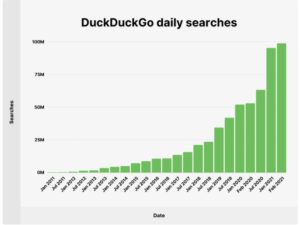The Method Episode #6

This method will get you more customers.
In 12 years, DuckDuckGo has grown from 0 to 100 Million daily searches and now owns 1% of the search market.
They never raised money and all their growth has been organic. How? Gabriel wrote a book about it called ‘traction’ where he breaks down his growth framework.
I don’t have the space here to outline the entire framework, which we’ve blogged about in depth. Instead, I’ll share what he calls the bullseye technique, which IMO is the core value add of traction.
The Bullseye Technique
Step 1: Brainstorm as many customer channels as you can think of, like; Radio, Tv, Newspaper, Business partnerships, Social media and so on.
– Review Kale’s dream 100 video for more ideas
Step 2: Think of one tactic you can use for each channel.
For example, you could run a Facebook ad; for radio, you could run a competition.
Step 3: Choose your top 5 channels and tactics from your list. ‘Top’ is subjective, so choose based on your knowledge, skillset and the product or service you sell.
Example: When I went through this exercise for my gym, I chose google ads because searches like ‘Dunedin gyms’ have high intent, and I had friends who knew how to run ads successfully.
Step 4: Run a test for each of your ideas. The point here is to move from theory to practical insights. Running tests will prove what idea is best from market feedback.
– Track your tests in a spreadsheet, updating results from month to month.
Step 5: Go all-in on the best performing channel. Whatever the tests prove is your best way to find new customers is where you now spend all your attention.
Step 6: Exhaust that channel before repeating the exercise and finding your next best channel.
What you’re doing here is starting with a bunch of opinions you have about finding customers and, through experimentation, proving what channel works best.
Worth Your Attention
Are you interested in Web 3.0 and NFT’s? Skip all the recycled rubbish online and listen to this conversation between two of the world’s thought leaders in this space. #Web3
A founders guide to getting your first 1,000 community members #Community
How to write copy that grabs peoples attention #Copywritting
Pod of the Week

Stories help you win.
When Reid Hoffman asked his top 5 masters of scale podcast guests what helped them win. All five credited story-telling.
Perhaps unsurprisingly, though, they all differed on how to tell a great story.
Stories matter because they help you cut through in a noisy world. Unless your business can promise an outrageous result like ‘this supplement guarantees you 8 hours sleep a night‘ or you have no competition, you’re competing for people’s attention without an obvious point of difference.
What I’ve mistakenly thought in the past is that if I can see why my business is better than its competitors, potential customers will be able to.
Worse yet, when I used language like ‘best equipment’ or ‘we’ll make you feel confident, we doubled down on being the same as everyone else. We were noisy but blended in with everyone else’s static.
Stories are a signal that evokes emotion so people can resonate with them and share them.
A turning point for Arrowtown Hair was when they decided to focus on sustainability and make it the underlying theme of the salon. When 10% of your market deeply cares about a story you’re telling, you will cut through.
Tyra Banks (America’s Next Top Model) thinks a remarkable story should take people on a journey because they imagine being part of that world. Since it’s hard to show people the journey, the most effective way is to work out loud and tell real-time stories.
^ This is what we did at Arrowtown Hair.
Brian Chesky (Air BnB) thinks the way to tell your story as a founder is passionate all the time in a way that everyone can relate to. Don’t just tell them what happened, but also why it happened and keep it simple stupid.
“Every time you tell a story, tell it as if it’s the first time.”
Angela Ahrendts (Former Burberry CEO) thinks being vulnerable and sharing with your team that you don’t always know what to do is a story that can unite your team.
“What is art but a way of seeing?” – John Berger.
Thinking Out Loud

The Art Of Noticing
The world’s best actresses, comedians, and writers all have one thing in common.
They tell great stories because they know how to notice.
As Stephen King refers to, the art of noticing is how you perceive environments and experiences and translate them into words.
To notice well, you need to use all five senses. The difference between a good storyteller and an average one is how many lenses you can recount an experience through.
These extra dimensions. The expression on someone’s face, the scent of their cologne, the country radio playing in the background, the once in a decade heatwave bring you into that moment.
When you bring a customer into your environment, you get a chance to leave an impression. These impressions, along with your grumpy customer service rep and a 20-minute walk from the closest car park, add up to your customer’s experience.
In my rarely travelled opinion. Bali offers some of the best hospitality experiences on this planet. Because they pay special attention to all of your senses, I can vividly recall the colours, music, lighting, and smell of restaurants I visited, three years ago.
Where-as I can’t tell you anything local cafe’s I’ve frequented 100’s of times.
What you see, what you hear, what you smell, what you feel, what you sense – is what you tell.
If you can give your customers something to notice, you will stand out in a seemingly un-differentiated marketplace. That difference can be all you need to make sure that person never revisits your competitors.
Get elevated and take notice of everything your customer is experiencing, not just your smile or your immaculately groomed carpet. What do they smell, hear, how bright are your lights, how uncomfortable are your couches? This all matters.
In this case, you don’t need to use language to them tell your story; they’re experiencing it instead.
Have a question or want to chat about anything you’ve read this week, join our community slack channel. Got someone in mind who needs to know about the method, send them here. As always – Thanks for Look’n.

